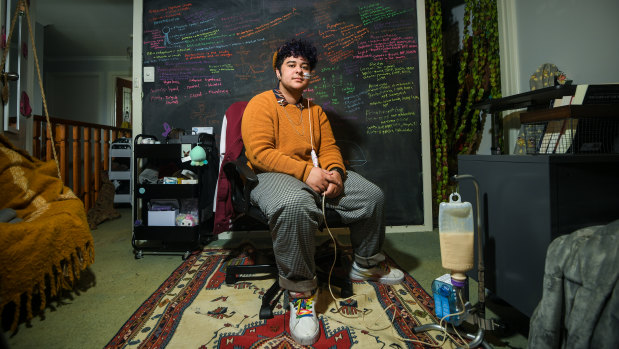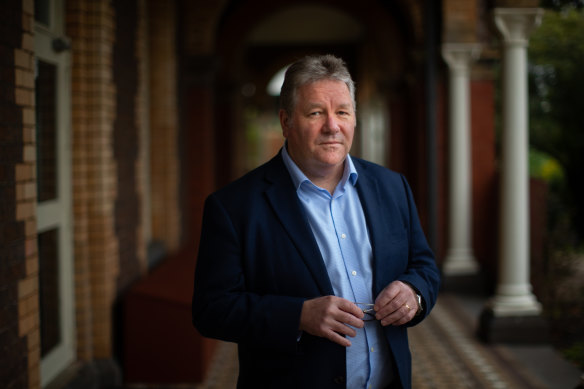Key points
- About 21 per cent of Victorian students need educational adjustment due to disability.
- Most students with a disability are in mainstream education,while there are 16,261 students enrolled in Victorian special schools.
- Children and Young People with Disabilities Australia chief executive Mary Sayers said in many ways, the “pandemic exacerbates existing inequality in the education system”.
Students with disabilities have been the worst affected by the upheaval caused by this year’s severe staff shortages in Victorian schools, according to principals, education experts and the students themselves.
Teacher absences have caused daily headaches for schools throughout 2022 as they return to full-time classroom learning while COVID-19 and other illnesses remain a constant threat to the health of staff and students.
Mac is 19, has a learning disability and is in a wheelchair and is completing his year 12 at TAFE. Credit:Justin McManus
The revolving door of teachers and reliance on casual fill-ins has been unsettling for many students, particularly those with disabilities who crave stability and rely on teachers understanding their specific learning needs.
Shane Kamsner, principal of specialist school Rossbourne, said daily disruptions had caused uncertainty for some students, and he had noticed behavioural changes “heighten with significant numbers of teachers away”.
“Self-regulation becomes more difficult, so they melt down much more quickly which indicates much higher levels of anxiety,” he said. Others become more panicky and take a long time to calm down, he said.
Shane Kamsner, principal of Rossbourne School in Hawthorn.Credit:Simon Schluter
While there are 16,261 students enrolled in Victorian special schools, such as Rossbourne, most students with a disability are in mainstream education.
Across the education system, about 21 per cent of Victorian students need educational adjustment due to a disability.
Frankston student Mac Zamani, 19, who is completing year 12 over two years at TAFE, said the needs of students with disabilities “aren’t always met because casual staff might not be aware” of them.
Zamani, who has a learning disability, chronic illnesses and is a wheelchair user, said lockdowns and remote learning had, in fact, made school more accessible for some people with disabilities, but only if their teachers understood their particular needs.
He said casual relief teachers often might come to a class unaware that a student was on an individual education plan, might not have had time to read the plan beforehand, or might not know the student well enough to action its instructions.
His own plan outlines the need to use headphones and an iPad.
“I’ve had teachers in class who come in and fill in … and get mad at me and threaten to give me detention. It has lots of implications. They don’t know what’s happening and it does affect our education,” he said.
Despite increasing teacher registrations, Victorian Principals Association president Andrew Dalgleish said staff absences had been problematic this year and students with disabilities were the most profoundly affected.
University of Melbourne professor of teacher education Larissa McLean Davies said the “most vulnerable students are made more vulnerable” any time teacher continuity was affected.
RMIT senior lecturer in special education and inclusion David Armstrong said he was “regularly contacted” by families of students with disabilities concerned about disruptions due to teacher shortages.
He said if schools were struggling to deliver the basic curriculum, “they are less inclined to have the resources and time and energy to support students with additional needs”.
“Many schools are scrambling every morning to fill the staffing that needs to have. If we are firefighting, longer-term stuff gets crowded out. Kids who have higher needs, they get crowded out – developmental work gets crowded out,” Armstrong said.
He said students with disabilities could become more isolated and unsettled, and this could lead to higher levels of “disruptive behaviours”.
Teagan Sjaardema, 17, is in Year 11 at a public school and has ADHD, dyslexia and a learning delay.
Sjaardema has an independent education plan, but says sometimes substitute teachers “just don’t know how to handle me”.
“They’ll say, ‘do this’, I say, ‘I don’t have to’ and they say ‘yes, you do’. They just don’t get told about me,” she said.
She has an aide, but finds they can get pulled in different directions when there is a substitute teacher who doesn’t know her.
“It’s challenging because the teacher doesn’t know what you are doing,” she said.
Victorian Principals Federation president Tina King said schools were doing their best to maintain routine and continuity for students, particularly for students with additional needs.
“In many ways the pandemic exacerbates existing inequality in the education system.”
“Have programs been disrupted? Absolutely. Has commitment maintained for student wellbeing? One hundred and fifty per cent,” King said.
She said open clear communication between families and the school was fundamental to successful changes to routine in programs, and “schools were certainly doing that”.
Children and Young People with Disabilities Australia chief executive Mary Sayers said: “In many ways the pandemic exacerbates existing inequality in the education system.”
“[It takes] strong relationships between family, child, parent and educators to ensure those reasonable adjustments are in place. When that is disrupted, every experience of the school is impacted.”
The Department of Education and Training said it was working closely with schools to ensure they met workforce demands and support students.
“Individual schools know better than anyone the unique needs of their students – and it is our expectation these needs are communicated if students are taught by a CRT, to make sure every student is getting the support they need to learn best,” he said.
The Morning Edition newsletter is our guide to the day’s most important and interesting stories, analysis and insights. Sign up here.
Most Viewed in National
From our partners
Source: Read Full Article


